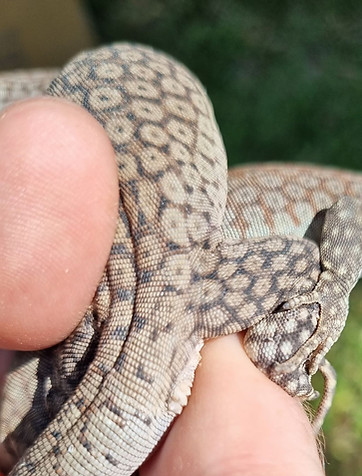

Varanus tristis orientalis
(Fry 1913)
-Freckled Monitor
-Ori


Young orientalis pair (Almaden locality)
Varanus tristis orientalis is a subspecies of Varanus tristis, and they are medium-sized Australian monitors with a smaller typical snout-vent length (excluding the tail) of around 25-28cm in adults. However, there is a variety of sizes even within the subspecies localities.
The coloration of orientalis monitors is varied between localities. In general, adults are typically lighter than regular tristis monitors, with more pronounced ocelli. As adults, the tail tips may become darker, but the heads generally remain similar to the body colour.
Physically, orientalis monitors have a long rounded tail and a longer body, which is typical of more arboreal monitors.
The distribution of orientalis is limited compared to the more arid tristis monitors, mostly confined to the eastern coastal side of Australia. However, the range of tristis and orientalis does overlap.
Habitats for orientalis monitors still vary, ranging from rock outcrops and sparse woodlands to forests. They are found hiding under rocks, in rock crevices, under bark on trees, in hollows, or under fallen logs.
Orientalis monitors are readily available in the Australian hobby, although finding some specific localities can be difficult. In captivity, their personality can vary. Some individuals remain quiet and reserved, while others are more outgoing. Overall, they are easily habituated to human contact. Tong and hand feeding can be established with most individuals, regardless of locality.
Here are the revised husbandry guidelines for Varanus tristis orientalis:
Enclosure size: Tristis orientalis monitors, being semi-arboreal, will utilize both terrestrial-style enclosures and vertical spaces for climbing. Due to the size variation within the subspecies, there is flexibility in recommended enclosure dimensions. However, a starting point for adult pairs is typically 1m x 1m x 1m.
Substrate and furnishings: Sand and soil substrate are suitable for this species. Providing plenty of hollows for hides or rock stacks for them to hide amongst is important. Scattering leaf litter on the floor also keeps them occupied for foraging.
Temperatures and lighting: Adequate UVB lighting is essential. A basking hot spot with a bright lamp directed onto a rock or tiles should have a temperature of around 50-65°C. The ambient heat gradient over the rest of the enclosure should be around 28-33°C during the warmer active months.
Humidity: Due to the wide range of habitats, some adjustments based on locality are advised. Regular misting in the warmer months can help maintain humidity. Humidity hides should be provided for this species.
Feeding: The bulk of their diet should consist of crickets, wood roaches, and other insects. Regular dusting of calcium powder and vitamins is necessary. Occasionally, you can include chopped pinkie mice, lean turkey or chicken mince, chopped chicken hearts, boiled chicken eggs, quail eggs, and chopped day-old quail. Maintaining a well-balanced variety is important.
Life span: The recorded life span of Varanus orientalis in captivity is around 12-15 years.
Distribution map based on ala.org.au point data.

Orientalis male spurs (Almaden Locality)

My Story
Orientalis Female (Yellow Throat Locality)
Contact
.